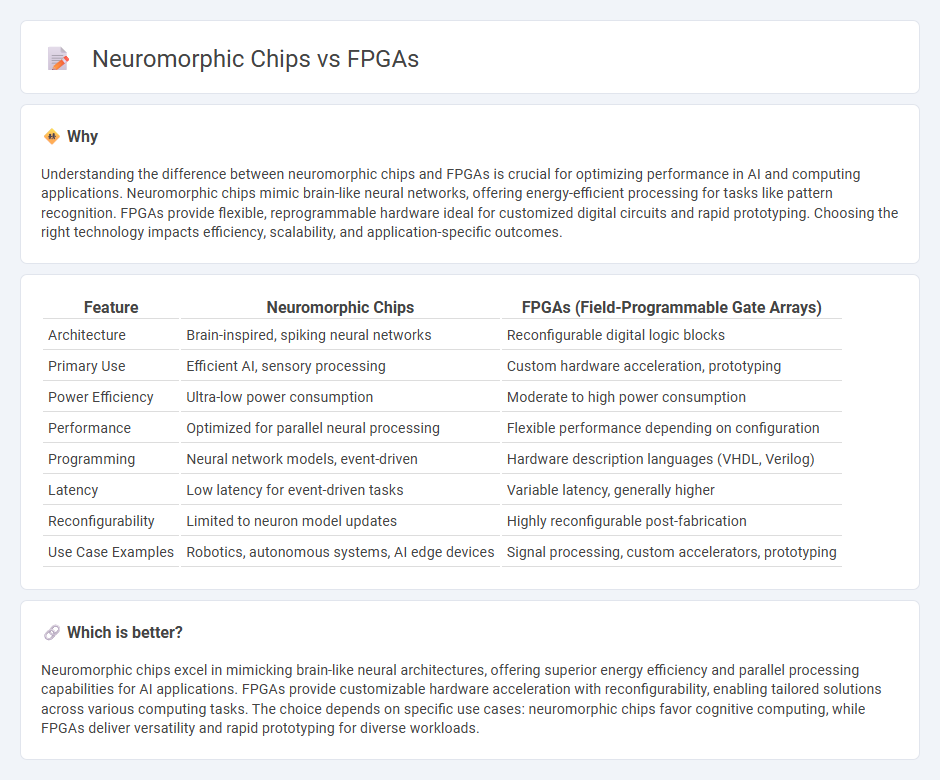
Neuromorphic chips mimic the human brain's neural architecture, enabling highly efficient parallel processing and low power consumption, ideal for AI and sensory applications. FPGAs offer reconfigurable hardware tailored for specific tasks, providing flexibility and rapid prototyping in diverse technology fields. Explore further to understand how these innovations revolutionize computing paradigms.
Why it is important
Understanding the difference between neuromorphic chips and FPGAs is crucial for optimizing performance in AI and computing applications. Neuromorphic chips mimic brain-like neural networks, offering energy-efficient processing for tasks like pattern recognition. FPGAs provide flexible, reprogrammable hardware ideal for customized digital circuits and rapid prototyping. Choosing the right technology impacts efficiency, scalability, and application-specific outcomes.
Comparison Table
| Feature | Neuromorphic Chips | FPGAs (Field-Programmable Gate Arrays) |
|---|---|---|
| Architecture | Brain-inspired, spiking neural networks | Reconfigurable digital logic blocks |
| Primary Use | Efficient AI, sensory processing | Custom hardware acceleration, prototyping |
| Power Efficiency | Ultra-low power consumption | Moderate to high power consumption |
| Performance | Optimized for parallel neural processing | Flexible performance depending on configuration |
| Programming | Neural network models, event-driven | Hardware description languages (VHDL, Verilog) |
| Latency | Low latency for event-driven tasks | Variable latency, generally higher |
| Reconfigurability | Limited to neuron model updates | Highly reconfigurable post-fabrication |
| Use Case Examples | Robotics, autonomous systems, AI edge devices | Signal processing, custom accelerators, prototyping |
Which is better?
Neuromorphic chips excel in mimicking brain-like neural architectures, offering superior energy efficiency and parallel processing capabilities for AI applications. FPGAs provide customizable hardware acceleration with reconfigurability, enabling tailored solutions across various computing tasks. The choice depends on specific use cases: neuromorphic chips favor cognitive computing, while FPGAs deliver versatility and rapid prototyping for diverse workloads.
Connection
Neuromorphic chips and FPGAs share a fundamental connection through their ability to mimic neural network architectures for enhanced computational efficiency. Neuromorphic chips are designed to replicate the brain's synaptic and neuronal functions, optimizing parallel processing and energy consumption. FPGAs provide customizable hardware platforms that can implement and accelerate neuromorphic algorithms, offering flexibility in prototyping and adapting neural-inspired computations.
Key Terms
Parallel Processing
FPGAs excel at parallel processing by allowing hardware-level customization to implement multiple concurrent data paths, optimizing throughput and latency for specific applications. Neuromorphic chips utilize massively parallel architectures modeled after biological neural networks, efficiently handling spiking data streams and event-driven computations with low power consumption. Explore more about the comparative strengths and use cases of FPGAs and neuromorphic chips in parallel processing.
Reconfigurability
Field-Programmable Gate Arrays (FPGAs) offer exceptional reconfigurability by enabling hardware-level customization post-manufacturing, allowing developers to tailor computing architectures for specific applications efficiently. Neuromorphic chips, inspired by the human brain, provide adaptive processing but lack the flexible hardware reprogramming capabilities found in FPGAs, limiting their reconfigurability to synaptic weight adjustments rather than structural changes. Explore the detailed advantages and trade-offs between FPGA reconfigurability and neuromorphic adaptability to optimize your hardware choice.
Spiking Neural Networks
Field-Programmable Gate Arrays (FPGAs) offer flexible hardware customization ideal for deploying Spiking Neural Networks (SNNs) with adjustable precision and parallel processing capabilities. Neuromorphic chips, designed to mimic biological neural systems, excel in energy-efficient implementation of SNNs by leveraging event-driven computation and asynchronous spike processing. Explore the comparative advantages and applications of FPGAs and neuromorphic chips to understand their impact on advancing spiking neural network technology.
Source and External Links
Field-programmable gate array - Wikipedia - An FPGA is a configurable integrated circuit that can be repeatedly programmed after manufacturing, used for digital functions with applications in telecommunications, automotive, aerospace, and more, often programmed using hardware description languages like VHDL.
What is an FPGA - Lattice Semiconductor - FPGAs enable custom logic development with re-programmable flexibility for applications such as AI, 5G, and robotics, offering parallel processing that increases performance with lower power consumption.
What is a field programmable gate array (FPGA)? - IBM - FPGAs are versatile integrated circuits programmable after manufacturing, combining high performance and configurability, widely used in high-performance computing and industries like telecommunications and aerospace.
 dowidth.com
dowidth.com